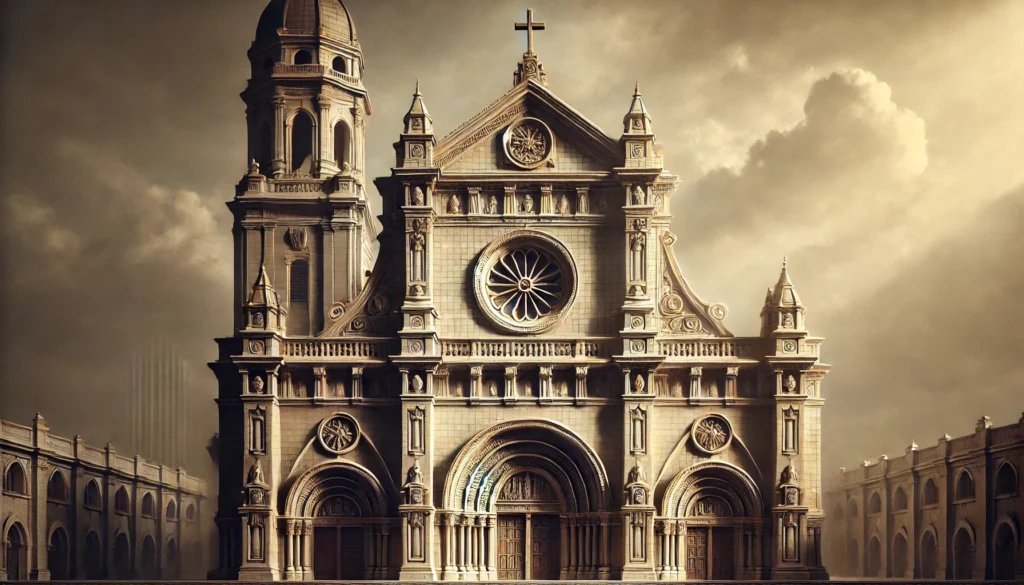The Manila Cathedral, officially known as the Minor Basilica and Metropolitan Cathedral of the Immaculate Conception, stands as a testament to the enduring influence of Spanish colonialism and Catholicism in the Philippines. Its history is deeply intertwined with the founding of Manila as a colonial capital and the establishment of the Catholic Church’s presence in the archipelago.
Foundation and Initial Construction
The origins of the Manila Cathedral date back to 1571 when Spanish conquistador Miguel López de Legazpi established Manila as the capital of the newly conquered Philippine Islands. The first structure was a simple church made of nipa and bamboo, materials readily available and commonly used in native Filipino architecture. This humble beginning belied the grand vision that would eventually manifest in the imposing stone cathedral we see today.
In 1581, the church was elevated to the status of cathedral, coinciding with the establishment of Manila as a suffragan diocese of Mexico. This marked a significant step in the Spanish colonial project, as it formalized the religious administration of the Philippines under the broader network of the Spanish Empire’s ecclesiastical structure.
Early Challenges and Reconstructions
The Manila Cathedral’s history is marked by a series of destructions and reconstructions, reflecting the tumultuous history of Manila itself. The table below summarizes the major rebuilding efforts in its early history:
| Year | Event |
|---|---|
| 1583 | First stone cathedral constructed |
| 1600 | Destroyed by earthquake, rebuilt |
| 1614 | Damaged by fire, repaired |
| 1645 | Severely damaged by earthquake, reconstructed |
| 1863 | Destroyed by earthquake, rebuilt |
Each reconstruction brought new elements to the cathedral’s design, incorporating prevailing architectural styles and structural improvements. These repeated rebuildings also serve as a metaphor for the resilience of both the Catholic faith and the Filipino people in the face of natural disasters.
Architectural Evolution and Significance
The Manila Cathedral’s architecture is a fusion of various styles, reflecting its long history and multiple reconstructions. Its current form, while relatively modern, draws inspiration from centuries of architectural evolution.
Baroque and Neoclassical Influences
During the Spanish colonial period, the cathedral’s design was heavily influenced by European Baroque and Neoclassical styles. These architectural movements, popular in Europe during the 17th to 19th centuries, were imported to the Philippines as part of the broader cultural influence of Spanish colonialism.
- Baroque elements included:
- Ornate decorations
- Dramatic use of light and shadow
- Emphasis on grandeur and spectacle
- Neoclassical features incorporated:
- Symmetry and proportion
- Use of classical Greek and Roman elements
- Simplicity and elegance in design
The blending of these styles created a unique architectural language that became characteristic of many colonial-era churches in the Philippines.
Modern Reconstruction and Design
The current structure of the Manila Cathedral dates from the post-World War II reconstruction, completed in 1958. This iteration of the cathedral, designed by architect Fernando Ocampo, sought to balance historical continuity with modern architectural principles.
Key features of the modern Manila Cathedral include:
- Romanesque-Byzantine style facade
- Intricate stone carvings depicting religious and historical scenes
- Large central dome flanked by smaller cupolas
- Stained glass windows created by Filipino artist Galo Ocampo
The reconstruction also incorporated seismic design principles, acknowledging the Philippines’ location in the Pacific Ring of Fire and the cathedral’s history of earthquake damage.
The Cathedral’s Role in Philippine History
Throughout its existence, the Manila Cathedral has been more than just a place of worship. It has played a central role in many significant events in Philippine history, serving as a silent witness to the nation’s triumphs and tribulations.
Center of Colonial Administration
During the Spanish colonial period, the cathedral was not only the seat of the Archbishop of Manila but also a de facto center of colonial administration. The close relationship between the Spanish colonial government and the Catholic Church meant that many important political decisions and ceremonies took place within or in the vicinity of the cathedral.
Wartime Destruction and Post-War Symbolism
The destruction of the Manila Cathedral during the Battle of Manila in 1945 was a poignant symbol of the devastation wrought by World War II on the Philippines. Its reconstruction in the 1950s became emblematic of the nation’s post-war recovery and renewal.
The rebuilt cathedral incorporated elements that honored this history:
- A chapel dedicated to the memory of those who died during World War II
- Artworks depicting scenes from Philippine history, including the war years
- Architectural elements salvaged from the ruins of the old cathedral
Venue for National and Religious Events
In the post-war era, the Manila Cathedral has continued to play a significant role in both religious and national life. It has been the site of:
- Papal visits, including those by Pope Paul VI (1970), Pope John Paul II (1981, 1995), and Pope Francis (2015)
- Inaugurations of several Philippine presidents
- State funerals for prominent national figures
- Annual religious processions and festivals
These events underscore the cathedral’s enduring importance as a symbol of both faith and national identity in the Philippines.
Artistic and Cultural Treasures
The Manila Cathedral houses numerous artistic and cultural treasures that reflect its rich history and spiritual significance. These elements contribute to its status as not just a religious site, but also a repository of Philippine art and culture.
Stained Glass Windows
One of the most striking features of the cathedral is its collection of stained glass windows. Created by Filipino artist Galo Ocampo, these windows depict various religious scenes and figures significant to Philippine Catholicism. The use of vibrant colors and intricate designs creates a mesmerizing play of light inside the cathedral, enhancing its spiritual atmosphere.
Sculptures and Carvings
The cathedral boasts an impressive array of sculptures and stone carvings, both inside and outside the building. Notable among these are:
- The tympanum above the main entrance, depicting the Immaculate Conception
- Statues of various saints and religious figures
- Intricate stone carvings on the facade and interior columns
These artworks not only serve a decorative purpose but also function as visual catechisms, telling biblical stories and reinforcing Catholic doctrines for the faithful.
Ecclesiastical Furnishings
The interior of the cathedral is adorned with numerous valuable ecclesiastical furnishings, many of which date back several centuries. These include:
- The main altar, made of Philippine hardwood and adorned with gold leaf
- Antique chandeliers, some salvaged from earlier versions of the cathedral
- Historic vestments and liturgical objects used in religious ceremonies
These items, beyond their practical use in worship, serve as tangible links to the cathedral’s long history and the broader narrative of Catholicism in the Philippines.
The Cathedral’s Impact on Filipino Catholicism
The Manila Cathedral’s influence extends far beyond its physical presence in the historic Intramuros district. As the seat of the Archdiocese of Manila, it has played a crucial role in shaping Filipino Catholicism and religious practice throughout the country.
Center of Ecclesiastical Authority
As the mother church of the Philippines, the Manila Cathedral has been the focal point of Catholic hierarchy in the country. The Archbishop of Manila, traditionally one of the most influential religious figures in the Philippines, governs from this cathedral. This centrality has allowed the cathedral to exert significant influence on religious practices, doctrinal interpretations, and social teachings throughout the Philippine Catholic Church.
Formation of Filipino Catholic Identity
The cathedral has been instrumental in the formation of a distinctly Filipino Catholic identity. This unique blend of indigenous Filipino culture and Spanish-influenced Catholicism is evident in:
- The incorporation of local languages and customs into liturgical practices
- The veneration of Filipino saints and blessed individuals
- The adaptation of Catholic feast days to align with pre-existing Filipino traditions
The Manila Cathedral has often been at the forefront of these cultural syntheses, setting examples that are followed by other churches across the country.
Hub of Religious Education and Outreach
Throughout its history, the cathedral has served as a center for religious education and outreach. This role has included:
- Training of priests and religious leaders
- Hosting of catechetical programs for the laity
- Organization of charitable activities and social services
These educational and outreach efforts have helped to maintain the strong influence of Catholicism in Philippine society, with the Manila Cathedral serving as a model for other dioceses and parishes.
Preservation Efforts and Modern Challenges
As a historical and cultural landmark, the Manila Cathedral faces ongoing challenges in preservation and maintenance. These efforts are crucial not only for the building’s physical integrity but also for its continued relevance in a rapidly changing urban and social landscape.
Structural Reinforcement and Restoration
Given the Philippines’ susceptibility to natural disasters, particularly earthquakes, ongoing structural reinforcement is a priority. Recent restoration efforts have included:
- Seismic retrofitting to improve earthquake resistance
- Restoration of degraded stonework and artistic elements
- Modernization of electrical and safety systems
These efforts aim to preserve the cathedral’s historical character while ensuring its safety and functionality for future generations.
Financial Challenges
The maintenance of such a large and historically significant structure presents considerable financial challenges. The cathedral relies on a combination of:
- Donations from the faithful
- Government grants for historical preservation
- Support from international Catholic organizations
Balancing the need for preservation with the cathedral’s ongoing religious and community functions requires careful financial management and prioritization.
Adapting to Contemporary Religious Practice
In an era of changing religious attitudes and practices, the Manila Cathedral faces the challenge of maintaining its relevance while preserving its traditions. This involves:
- Incorporating modern technology for outreach and communication
- Adapting liturgical practices to engage younger generations
- Addressing contemporary social issues within the framework of Catholic teaching
The cathedral’s leadership must navigate these changes while maintaining the site’s historical and spiritual integrity.
Conclusion: The Manila Cathedral’s Enduring Legacy
The Manila Cathedral stands as a powerful symbol of the intertwining of faith, history, and national identity in the Philippines. From its humble beginnings as a simple church of nipa and bamboo to its current status as a minor basilica and architectural landmark, the cathedral has been a constant presence through centuries of change and upheaval.
Its repeated destructions and reconstructions mirror the resilience of the Filipino people, while its artistic treasures and cultural significance make it a unique repository of Philippine heritage. As both a functioning church and a historical monument, the Manila Cathedral continues to play a vital role in the spiritual and cultural life of the nation.
As the Philippines moves forward in the 21st century, the Manila Cathedral remains a bridge between the country’s colonial past and its independent present. It serves as a reminder of the complex legacy of Spanish colonialism and the enduring influence of Catholicism on Filipino society. At the same time, it stands as a testament to the Filipino people’s ability to adapt, integrate, and create a unique cultural identity from diverse influences.
The challenges of preservation and relevance in a rapidly changing world ensure that the story of the Manila Cathedral is far from over. As it has done for centuries, this remarkable building will undoubtedly continue to evolve, adapt, and inspire future generations of Filipinos, remaining a steadfast symbol of faith, resilience, and national pride.
Disclaimer: While every effort has been made to ensure the accuracy of the information presented in this article, readers are encouraged to report any inaccuracies or outdated information. The field of historical research is continually evolving, and new discoveries or interpretations may emerge. We are committed to reviewing and updating our content promptly to maintain its accuracy and relevance.




